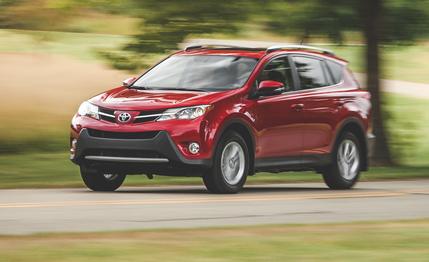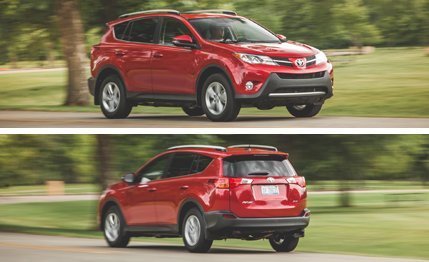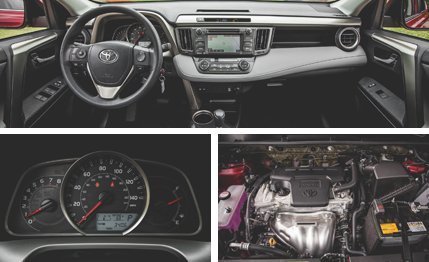 Instrumented Test
Instrumented Test
The Toyota RAV4 has scored consistently good marks in the areas of utility, all-around usefulness, fuel efficiency, comfort, quality, and value ever since it became the progenitor of the small, car-based crossover species in 1996. But an engaging driving experience isn’t something we would necessarily add to the list of the diminutive Toyota’s defining characteristics.
Redesigned for model-year 2013, the RAV4 is now in its fourth generation, a makeover that eliminated one of the elements that gave the third generation a jolt of fun-to-drive: the optional 3.5-liter V-6 with 269 horsepower and 246 lb-ft of torque. So equipped, a 2010 RAV4 V-6 hustled to 60 mph in 6.4 seconds, making it the hottest thing in the class.

But in 2013, the gen-four RAV’s powertrain options were pared down to a 2.5-liter four-cylinder teamed with a six-speed automatic transmission. The choice of front- or all-wheel drive remained. This adds up to tepid acceleration. In our first trip to the test track with a 2013 RAV4 AWD, it ran to 60 in 8.2 seconds, and the quarter-mile came in 16.5 at 85 mph. That’s at the slow end of the compact-crossover scale, and for some reason this front-drive test subject, although 118 pounds lighter than the AWD model, was slower by a half-second to 60 and a couple tenths through the quarter. (Chalk up the disparity to a green engine in the front-driver with too-few break-in miles; the RAV isn’t powerful enough to gain an accelerative advantage from AWD.) The six-speed automatic is smooth, and manual shifting, achieved by waggling the lever fore and aft, is helpful for two-lane passing, a maneuver that requires careful planning due to the modest propulsion.
Although the RAV4’s acceleration requires a patient driver, its dynamic deportment is generally responsive. True, the crossover’s understeer progresses from significant to resolute, but its responses are prompt and utterly predictable within that limit. Body motions are well controlled with a firm but smooth ride. The RAV4’s electric power steering is a little vague but reasonably quick at 2.7 turns lock-to-lock.
The RAV4’s braking system was fade-free, but its 70-to-0-mph stopping distances were lengthy, ranging from 189 to 194 feet. This is not unusual for the class, but it’s nevertheless lamentable. On the other hand, the little Toyota’s grip was respectable by segment standards: 0.75 g on the skidpad. The body shell feels solid, even over washboard surfaces, with no buzz resonating from the chassis.

If sporty handling is a priority, Mazda’s CX-5 and the Ford Escape are better choices. But if the RAV4 isn’t exactly entertaining, it’s certainly competent.
The RAV’s real virtues lie elsewhere, with quiet operation, generally good interior materials, a handy open storage shelf on the passenger side of the dashboard, adult-size rear legroom, and generous cargo capacity topping the list. And as noted in our previous report, a low liftover height at the rear takes some of the strain out of sliding in bulky stuff, a real plus.
The new-generation RAV4 is strictly a five-passenger ride (no teeny-tiny third row as in the last one), and it finally ditched its trademark side-hinged rear gate and spare-tire carrier. As a matter of style, some may miss the distinction of the rear-mounted spare. But stowing the spare below the cargo floor and going to a conventional hatchback is more practical.
Practical value is what the latest RAV4 is all about. Our XLE test subject was well equipped, with only one option over $500: Entune Premium Audio ($585) with a 6.1-inch touch screen, a USB port, iPod connectivity, hands-free phone operation, voice command, and a rearview camera. It may not sing to your inner race-car driver, but at just over $27,000 as-tested, the RAV4 represents the most sensible of shoes in a Hush Puppies world.